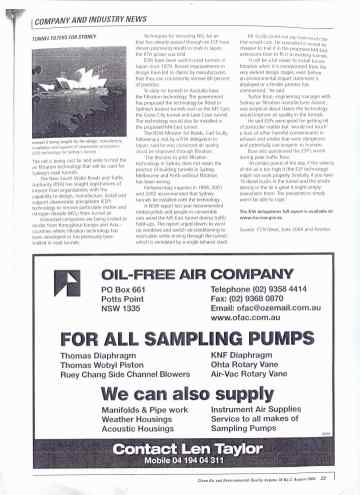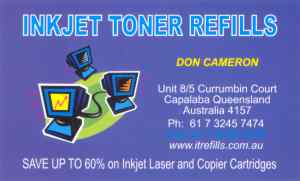

TUNNEL FILTERS FOR SYDNEY
Interest is being sought for the design, manufacture, installation and support of cleanostatic precipitator (ESP) technology for Sydney's tunnels.
The net is being cast far and wide to find the air filtration technology that will be used for Sydney's road tunnels.The New South Wales Roads and Traffic Authority (RTA) has sought registrations of interest from organisations with the capability to design, manufacture, install and support cleanostatic precipitator (ESP) technology to remove particulate matter and nitrogen dioxide (NO2) from tunnel air.
Interested companies are being invited to tender from throughout Europe and Asia -countries where filtration technology has been developed or has previously been trailed in road tunnels.Techniques for removing NO2 for air that has already passed through an ESP have shown promising results in trials in Japan, the RTA group was told.ESPs have been used in road tunnels in Japan since 1979. Recent improvements in design have led to claims by manufacturers that they can consistently remove 80 percent of particles.
To date no tunnels in Australia have the filtration technology. The government has proposed the technology be fitted in Sydney's busiest tunnels such as the M5 East, the Cross City tunnel and Lane Cove tunnel.The technology would also be installed in the proposed M4 East tunnel.
The NSW Minister for Roads, Carl Scully, following a visit by a RTA delegation to Japan, said he was convinced air quality could be improved through filtration.'The decision to pilot filtration technology in Sydney does not mean the practice of building tunnels in Sydney, Melbourne and Perth without filtration has been wrong.
Parliamentary inquiries in 1999, 2001 and 2002 recommended that Sydney tunnels be installed with the technology.
A NSW report last year recommended motorcyclists and people in convertible cars avoid the M5 East tunnel during traffic hold-ups. The report urged drivers to wind up windows and switch air-conditioning to recirculate while driving through the tunnel, which is ventilated by a single exhaust stack.
Mr Scully could not say how much the trial would cost. He conceded it would be cheaper to trial it in the proposed M4 East extensions than to fit it to existing tunnels.
It will be a lot easier to install tunnel filtration when it is incorporated from the very earliest design stages, even before an environmental impact statement is displayed or a tender process has commenced,' he said.
Tushar Bose, engineering manager with Sydney air filtration manufacturer Aironic, was sceptical about claims the technology would improve air quality in the tunnels.
He said ESPs were good for getting rid of particular matter but 'would not touch' a host of other harmful contaminants in exhaust and smoke that were dangerous and potentially carcinogenic to humans.Bose also questioned the ESP's worth during peak traffic flow.
'At certain points of the day, if the velocity of the air is too high it (the ESP technology) might not work properly. Similarly, if you have , 10 diesel trucks in the tunnel and the smoke density in the air is great it might simply overwhelm them. The precipitators simply won't be able to cope.'
The RTA delegations full report is available at: www.rta.nsw.gov.auSource: CCN News, June 2004 and Aironics.
From: Clean Air and Environment Quality Vol 38 No 3 Page 23.


This page is maintained by
The Rivermouth Action Group Inc
as a community service.
E-mail: activist@rag.org.au

